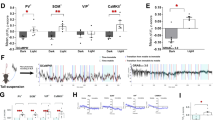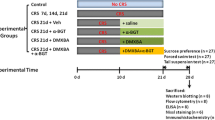Abstract
Acetylcholine (ACh) levels are elevated in actively depressed subjects. Conversely, antagonism of either nicotinic or muscarinic ACh receptors can have antidepressant effects in humans and decrease stress-relevant behaviors in rodents. Consistent with a role for ACh in mediating maladaptive responses to stress, brain ACh levels increase in response to stressful challenges, whereas systemically blocking acetylcholinesterase (AChE, the primary ACh degradative enzyme) elicits depression-like symptoms in human subjects, and selectively blocking AChE in the hippocampus increases relevant behaviors in rodents. We used an ACh sensor to characterize stress-evoked ACh release, then used chemogenetic, optogenetic and pharmacological approaches to determine whether cholinergic inputs from the medial septum/diagonal bands of Broca (MSDBB) or ChAT-positive neurons intrinsic to the hippocampus mediate stress-relevant behaviors in mice. Chemogenetic inhibition or activation of MSDBB cholinergic neurons did not result in significant behavioral effects, while inhibition attenuated the behavioral effects of physostigmine. In contrast, optogenetic stimulation of septohippocampal terminals or selective chemogenetic activation of ChAT-positive inputs to hippocampus increased stress-related behaviors. Finally, stimulation of sparse ChAT-positive hippocampal neurons increased stress-related behaviors in one ChAT-Cre line, which were attenuated by local infusion of cholinergic antagonists. These studies suggest that ACh signaling results in maladaptive behavioral responses to stress if the balance of signaling is shifted toward increased hippocampal engagement.





Similar content being viewed by others
References
Saricicek A, Esterlis I, Maloney KH, Mineur YS, Ruf BM, Muralidharan A, et al. Persistent beta2*-nicotinic acetylcholinergic receptor dysfunction in major depressive disorder. Am J psychiatry. 2012;169:851–9.
Hannestad JO, Cosgrove KP, DellaGioia NF, Perkins E, Bois F, Bhagwagar Z, et al. Changes in the cholinergic system between bipolar depression and euthymia as measured with [123I]5IA single photon emission computed tomography. Biol psychiatry. 2013;74:768–76.
Esterlis I, Hannestad JO, Bois F, Sewell RA, Tyndale RF, Seibyl JP, et al. Imaging changes in synaptic acetylcholine availability in living human subjects. J Nucl Med. 2013;54:78–82.
Janowsky DS, el-Yousef MK, Davis JM, Sekerke HJ. A cholinergic-adrenergic hypothesis of mania and depression. Lancet. 1972;2:632–5.
Risch SC, Cohen RM, Janowsky DS, Kalin NH, Sitaram N, Gillin JC, et al. Physostigmine induction of depressive symptomatology in normal human subjects. Psychiatry Res. 1981;4:89–94.
Drevets WC, Zarate CA, Jr., Furey ML. Antidepressant effects of the muscarinic cholinergic receptor antagonist scopolamine: a review. Biol psychiatry 2012;73:1156–63.
Janowsky DS. Serendipity strikes again: scopolamine as an antidepressant agent in bipolar depressed patients. Curr Psychiatry Rep. 2011;13:443–5.
George TP, Sacco KA, Vessicchio JC, Weinberger AH, Shytle RD. Nicotinic antagonist augmentation of selective serotonin reuptake inhibitor-refractory major depressive disorder: a preliminary study. J Clin Psychopharmacol. 2008;28:340–4.
Mineur YS, Picciotto MR. Nicotine receptors and depression: revisiting and revising the cholinergic hypothesis. Trends Pharm Sci. 2010;31:580–6.
Mineur YS, Ernstsen C, Islam A, Lefoli Maibom K, Picciotto MR. Hippocampal knockdown of alpha2 nicotinic or M1 muscarinic acetylcholine receptors in C57BL/6J male mice impairs cued fear conditioning. Genes, brain, Behav. 2020;19:e12677.
Tottenham N, Sheridan MA. A review of adversity, the amygdala and the hippocampus: a consideration of developmental timing. Front Hum Neurosci. 2009;3:68.
Sapolsky RM. The possibility of neurotoxicity in the hippocampus in major depression: a primer on neuron death. Biol psychiatry. 2000;48:755–65.
Selden NR, Gitelman DR, Salamon-Murayama N, Parrish TB, Mesulam MM. Trajectories of cholinergic pathways within the cerebral hemispheres of the human brain. Brain. 1998;121:2249–57.
Mesulam MM. Cholinergic pathways and the ascending reticular activating system of the human brain. Ann N. Y Acad Sci. 1995;757:169–79.
Drever BD, Riedel G, Platt B. The cholinergic system and hippocampal plasticity. Behavioural brain Res. 2011;221:505–14.
Gilad GM. The stress-induced response of the septo-hippocampal cholinergic system. A vectorial outcome of psychoneuroendocrinological interactions. Psychoneuroendocrinology. 1987;12:167–84.
Gilad GM, Gilad VH, Tizabi Y. Aging and stress-induced changes in choline and glutamate uptake in hippocampus and septum of two rat strains differing in longevity and reactivity to stressors. International journal of developmental neuroscience: the official journal of the International Society for. Developmental Neurosci. 1990;8:709–13.
Yamaguchi T, Danjo T, Pastan I, Hikida T, Nakanishi S. Distinct roles of segregated transmission of the septo-habenular pathway in anxiety and fear. Neuron. 2013;78:537–44.
Frotscher M, Vida I, Bender R. Evidence for the existence of non-GABAergic, cholinergic interneurons in the rodent hippocampus. Neuroscience. 2000;96:27–31.
Yi F, Catudio-Garrett E, Gabriel R, Wilhelm M, Erdelyi F, Szabo G, et al. Hippocampal “cholinergic interneurons” visualized with the choline acetyltransferase promoter: anatomical distribution, intrinsic membrane properties, neurochemical characteristics, and capacity for cholinergic modulation. Front synaptic Neurosci. 2015;7:4.
Masiulis I, Yun S, Eisch AJ. The interesting interplay between interneurons and adult hippocampal neurogenesis. Mol Neurobiol. 2011;44:287–302.
Kolisnyk B, Guzman MS, Raulic S, Fan J, Magalhaes AC, Feng G, et al. ChAT-ChR2-EYFP mice have enhanced motor endurance but show deficits in attention and several additional cognitive domains. J Neurosci. 2013;33:10427–38.
Robinson J, Manseau F, Ducharme G, Amilhon B, Vigneault E, El Mestikawy S, et al. Optogenetic activation of septal glutamatergic neurons drive hippocampal theta rhythms. J Neurosci. 2016;36:3016–23.
Crouse RB, Kim K, Batchelor HM, Girardi EM, Kamaletdinova R, Chan J et al. Acetylcholine is released in the basolateral amygdala in response to predictors of reward and enhances the learning of cue-reward contingency. Elife 2020;9:e57335.
Crawley JN. Behavioral phenotyping strategies for mutant mice. Neuron. 2008;57:809–18.
Chen E, Lallai V, Sherafat Y, Grimes NP, Pushkin AN, Fowler JP, et al. Altered baseline and nicotine-mediated behavioral and cholinergic profiles in chat-cre mouse lines. J Neurosci. 2018;38:2177–88.
Cope ZA, Lavadia ML, Joosen AJM, van de Cappelle CJA, Lara JC, Huval A et al. Converging evidence that short-active photoperiod increases acetylcholine signaling in the hippocampus. Cogn, affect & behav neurosci. 2020;20:1173–83
Picciotto MR, Higley MJ, Mineur YS. Acetylcholine as a neuromodulator: cholinergic signaling shapes nervous system function and behavior. Neuron. 2012;76:116–29.
Neugebauer NM, Einstein EB, Lopez MB, McClure-Begley TD, Mineur YS, Picciotto MR. Morphine dependence and withdrawal induced changes in cholinergic signaling. Pharmacol, Biochem, Behav. 2013;109:77–83.
Harrison V, Mackenzie, Ross S. Anxiety and depression following cumulative low-level exposure to organophosphate pesticides. Environ Res. 2016;151:528–36.
Jaga K, Dharmani C. The interrelation between organophosphate toxicity and the epidemiology of depression and suicide. Rev Environ Health. 2007;22:57–73.
Imperato A, Puglisi-Allegra S, Casolini P, Angelucci L. Changes in brain dopamine and acetylcholine release during and following stress are independent of the pituitary-adrenocortical axis. Brain Res. 1991;538:111–7.
Imperato A, Puglisi-Allegra S, Casolini P, Zocchi A, Angelucci L. Stress-induced enhancement of dopamine and acetylcholine release in limbic structures: role of corticosterone. Eur J Pharmacol. 1989;165:337–8.
Mineur YS, Obayemi A, Wigestrand MB, Fote GM, Calarco CA, Li AM, et al. Cholinergic signaling in the hippocampus regulates social stress resilience and anxiety- and depression-like behavior. Proc Natl Acad Sci USA. 2013;110:3573–8.
Sternfeld M, Shoham S, Klein O, Flores-Flores C, Evron T, Idelson GH, et al. Excess “read-through” acetylcholinesterase attenuates but the “synaptic” variant intensifies neurodeterioration correlates. Proc Natl Acad Sci USA. 2000;97:8647–52.
Woolf NJ. Cholinergic systems in mammalian brain and spinal cord. Prog Neurobiol. 1991;37:475–524.
Di Liberto V, Frinchi M, Verdi V, Vitale A, Plescia F, Cannizzaro C, et al. Anxiolytic effects of muscarinic acetylcholine receptors agonist oxotremorine in chronically stressed rats and related changes in BDNF and FGF2 levels in the hippocampus and prefrontal cortex. Psychopharmacology. 2017;234:559–73.
Mineur YS, Mose TN, Blakeman S, Picciotto MR. Hippocampal alpha7 nicotinic ACh receptors contribute to modulation of depression-like behaviour in C57BL/6J mice. Br J Pharmacol. 2018;175:1903–14.
Zhang Y, Jiang YY, Shao S, Zhang C, Liu FY, Wan Y, et al. Inhibiting medial septal cholinergic neurons with DREADD alleviated anxiety-like behaviors in mice. Neurosci Lett. 2017;638:139–44.
Manvich DF, Webster KA, Foster SL, Farrell MS, Ritchie JC, Porter JH, et al. The DREADD agonist clozapine N-oxide (CNO) is reverse-metabolized to clozapine and produces clozapine-like interoceptive stimulus effects in rats and mice. Sci Rep. 2018;8:3840.
Packer AM, Roska B, Hausser M. Targeting neurons and photons for optogenetics. Nat Neurosci. 2013;16:805–15.
Degroot A, Treit D. Anxiety is functionally segregated within the septo-hippocampal system. Brain Res. 2004;1001:60–71.
Menard J, Treit D. Lateral and medial septal lesions reduce anxiety in the plus-maze and probe-burying tests. Physiol Behav. 1996;60:845–53.
Moor E, DeBoer P, Westerink BH. GABA receptors and benzodiazepine binding sites modulate hippocampal acetylcholine release in vivo. Eur J Pharmacol. 1998;359:119–26.
Pisanello M, Pisano F, Sileo L, Maglie E, Bellistri E, Spagnolo B, et al. Tailoring light delivery for optogenetics by modal demultiplexing in tapered optical fibers. Sci Rep. 2018;8:4467.
Disney AA, Higley MJ. Diverse spatiotemporal scales of cholinergic signaling in the neocortex. J Neurosci. 2020;40:720–5.
Bello SM, Perry MN, Smith CL. Know your model: a knockout does not always make a null. Lab Anim (NY). 2020;49:59–60.
Saunders A, Granger AJ, Sabatini BL. Corelease of acetylcholine and GABA from cholinergic forebrain neurons. Elife 2015;4:e06412.
Trudeau LE, El, Mestikawy S. Glutamate cotransmission in cholinergic, GABAergic and monoamine systems: contrasts and commonalities. Front Neural Circuits. 2018;12:113.
Harris JA, Hirokawa KE, Sorensen SA, Gu H, Mills M, Ng LL, et al. Anatomical characterization of Cre driver mice for neural circuit mapping and manipulation. Front Neural Circuits. 2014;8:76.
Bruno CA, O’Brien C, Bryant S, Mejaes JI, Estrin DJ, Pizzano C, et al. pMAT: An open-source software suite for the analysis of fiber photometry data. Pharmacol, Biochem, Behav. 2021;201:173093.
Jean-Richard-Dit-Bressel P, Clifford CWG, McNally GP. Analyzing event-related transients: confidence intervals, permutation tests, and consecutive thresholds. Front Mol Neurosci. 2020;13:14.
Acknowledgements
These studies were supported by National Institutes of Health grants MH077681, MH105824 and DA033945 from the National Institutes of Health and a NARSAD Distinguished Investigator grant from the Brain and Behavior Research Foundation. This work was funded in part by the State of Connecticut, Department of Mental Health and Addiction Services, but this publication does not express the views of the Department of Mental Health and Addiction Services or the State of Connecticut. We thank the National Institutes of Health Drug Supply Program for providing CNO.
Author information
Authors and Affiliations
Contributions
YSM designed, carried out and contributed to all experiments, analyzed data, and wrote the manuscript. TNM, AI, CNM, DCT, MB conducted DREADD experiments, histology, and analyses; LV, RCB conducted optogenetics experiments, histology, and analyses; IME and CO conducted fiber photometry experiments, histology, and analyses; WZ carried out electrophysiological recordings and analyses. MRP designed the study, analyzed outcomes, and wrote the manuscript. All authors reviewed and approved the manuscript.
Corresponding author
Ethics declarations
Competing interests
The authors declare no competing interests.
Additional information
Publisher’s note Springer Nature remains neutral with regard to jurisdictional claims in published maps and institutional affiliations.
Rights and permissions
About this article
Cite this article
Mineur, Y.S., Mose, T.N., Vanopdenbosch, L. et al. Hippocampal acetylcholine modulates stress-related behaviors independent of specific cholinergic inputs. Mol Psychiatry 27, 1829–1838 (2022). https://doi.org/10.1038/s41380-021-01404-7
Received:
Revised:
Accepted:
Published:
Issue Date:
DOI: https://doi.org/10.1038/s41380-021-01404-7
- Springer Nature Limited
This article is cited by
-
Basal forebrain cholinergic signalling: development, connectivity and roles in cognition
Nature Reviews Neuroscience (2023)
-
Stress-induced changes of the cholinergic circuitry promote retrieval-based generalization of aversive memories
Molecular Psychiatry (2022)
-
The interaction between hippocampal cholinergic and nitrergic neurotransmission coordinates NMDA-dependent behavior and autonomic changes induced by contextual fear retrieval
Psychopharmacology (2022)




